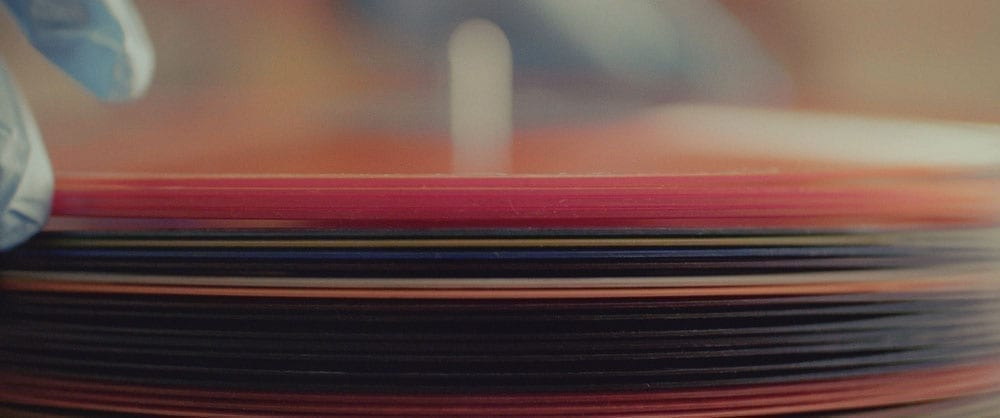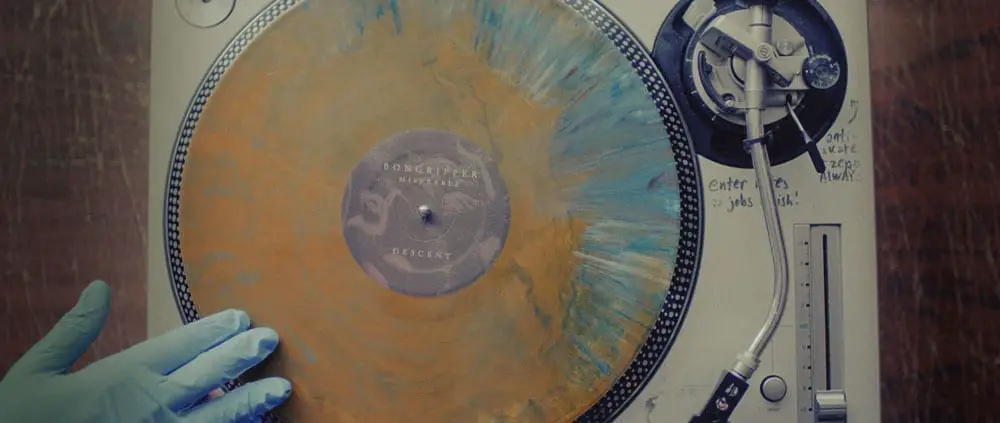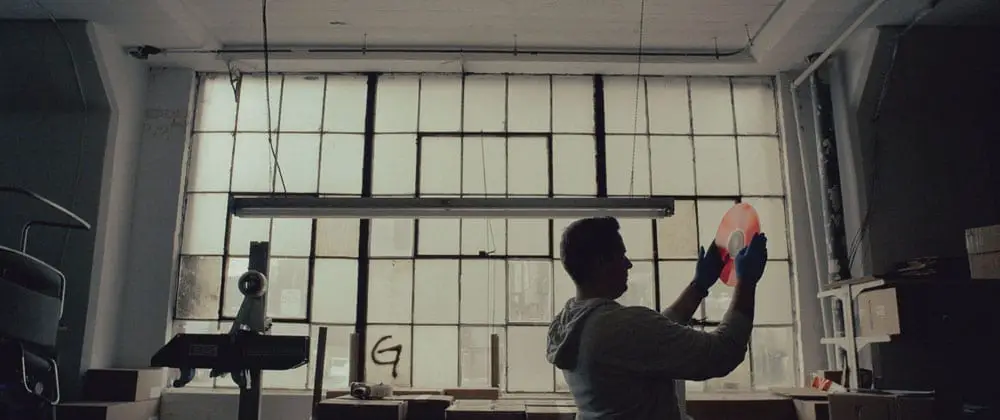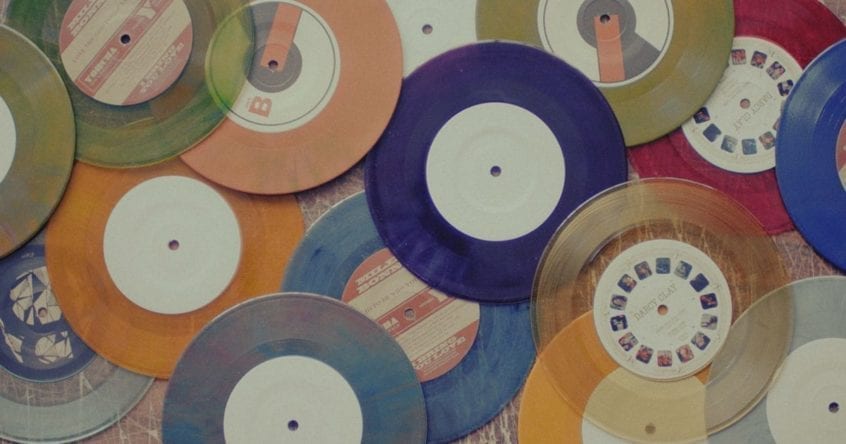Colored vinyl gets a bad wrap among vinyl and HiFi circles. For years, colored pressings were infamous for lousy quality. They are subsequently cast aside to this day by many as little more than a marketing gimmick. But is this really fair? Can the color of a vinyl record really make that much difference?

On face value, a debate around how color might affect the sound quality of one pressing over another appears inconsequential, almost smoke and mirrors. As with most things, though, when you did a little deeper, you begin to see the wood from the trees—a little method in the madness.
To help decipher truth from fiction, we spoke to Matt Earley of Gotta Groove Records (a pressing plant based in Cleveland, Ohio). Matt was able to provide a fantastic insight into the trials and tribulations of working with different colors in the vinyl manufacturing process.
When I first began investigating vinyl color and the impact on production quality, it became apparent pretty quickly that I was approaching a contentious topic. Most of the information available online is shrowded in pseudoscience, and of those I spoke to directly, many of their answers were inconclusive or ambiguous. At the same time, I think it’s important to stress that, while Matt was extremely helpful and forthcoming with his knowledge, he can only speak for his own unique experience at Gotta Groove Records. Speak to a different plant, and their experience or opinion may vary entirely.
“The reason different colors have varying sound characteristics on vinyl is because of how they mold. A contributor in how they mold is what’s used as the colorant.”
Matt Earley
Gotta Groove Records opened in 2009 as one of the first new US pressing plants to open in decades. They acquired all of their machinery from Dynamic Sun Records, a long-established pressing plant in New Jersey, when its owner decided to retire. Over the last ten years, the company has gone from strength to strength, having worked on over 9000 individual releases to this day.
Before we get into the nuts and bolts of Gotta Groove’s experience with colored vinyl, it’s important to establish some basics.
All vinyl records are made of PVC, which naturally has no color; it appears white, but can show light through if held up to a light source. To change the appearance of natural PVC, colorants are added to the mix. In the case of traditional black records, black carbon is often added, which also strengthens the PVC mix. As a general rule of thumb, traditional black vinyl and natural, un-colored vinyl produce the best results overall. Matt explains further. “Certainly with our black vinyl, carbon is used as the colorant. As far as I understand, this can reduce static electricity, but the biggest contributor to black vinyl performance is more down to the fact it’s the most prevalent color, it’s the most often run, and therefore it’s the most consistent. When we switch from black to colored vinyl on any of our pressings, there’s a lot of finesse involved in changing over as all materials run dramatically different. Whereas with black vinyl, you can run that on any press on any day, and while every record runs a little differently, you know the vinyl itself is going to be pretty consistent. For me, this is the biggest overriding factor in why black is said to sound better.”
In any manufacturing process, of course, there are always exceptions. Every record runs differently, and there are no doubt variables from one pressing to the next, let alone one pressing plant to the next. “We’ve certainly found exceptions to the ‘black is best’ rule. There are some records we’ve run that seem to run much better on a transparent color. For whatever reason, just the way the grooves form seems to work better in some instances. For example, sometimes when you have a record that has a lot of molding issues (like non-fill on black vinyl), much of those molding issues can go away due to the softer nature of colored vinyl.”

As my conversation with Matt unfolds, what becomes clear is that ‘color’ in itself does not directly affect the sound quality of a record. Instead, the difference in performance lies more in how each material molds. “The reason different colors have varying sound characteristics on vinyl is because of how they mold,” Matt continues. “A contributor in how they mold is what’s used as the colorant. So, for example, when we run a white record, in our experience, we find this to be one of the noisest colors. When white vinyl is mixed with other colors, this only serves to exacerbate the issue further. I don’t want to say they’re generally terribly fallible records all the time, but if you were to compare one with say the exact same record on black, you’d likely hear a difference. So with black vinyl, we know the colorant is always going to be carbon, but with other colors the colorant will vary from one to the next, and this introduces a variable.”
White vinyl is not to be confused with natural vinyl, of course, which actually runs fairly well. Natural vinyl is a translucent white, while solid white vinyl has a colorant added, making it opaque. “Natural translucent white actually runs really well,” Matt exclaims. “I’d say, similar to black, but not identical. The variable being that it’s a more malleable color (similar to a transparent). The carbon added to black vinyl certainly adds some rigidity.”
“Transparent vinyl overall, actually (including transparent colors), we find sound great most of the time. A lot of the time, we’ll run releases where there’s a black version and a colored version, and in most cases, we don’t experience any differences between the black and clear versions. That is, at least from the perspective of a persistent type of noise, like a sustained noise floor, for example. However, opaque colored vinyl, in general, from a manufacturing viewpoint, tends not to run as consistently as black vinyl.”
PVC manufacturers keep the recipes for producing vinyl pellets pretty close to their chest. Therefore, it stands to good reason that a change in supplier may introduce a further variant. I asked Matt if supplier changes had ever thrown further variables into the mix. “Oh, absolutely, we’ve been forced to change suppliers a few times over the years. Seven or eight years ago, we were using a company called Rimtec until they decided to get out of the market. After that, we had to shop around the world to find a new supplier. The issue with this as a pressing plant is you don’t truly know what you’re getting into until a good eight to ten months of running the new stock. Often you can run a sample to find out pretty quickly if it’ll work or not, but you’re still not going to know the more delicate intricacies of how it’ll run on various record runs within that short trial. We tried a few companies before settling on TPC as our main supplier, which runs more similarly to the Rimtec PVC we liked. It’s trial and error when changing suppliers, which can get pretty expensive and takes time.”
“Random colored vinyl does tend to be noisy, and it’s difficult to predict. You have all the different colors, all mixing together, and each color is from a different formula of vinyl pellet, with different melting characteristics.”
Matt Earley
So far, we’ve established that, as a general rule, black and natural vinyl produce the best results (at least from the insight we’ve gained from Matt’s experience). We can also say that, of the opaque color options, white tends to perform worse than other color options, but what about the other, more artistic designs? Well, there are further caveats here. Speaking on mastering engineer Scott Hull’s recent podcast, Matt was also able to share some further experience concerning the use of multiple colors, or handmade, art splatter designs.
“With different random colors: the quality can vary greatly”, Matt states. “Random colored vinyl does tend to be noisy, and it’s difficult to predict. You have all the different colors, all mixing together, and each color is from a different formula of vinyl pellet, with different melting characteristics. Therefore, you’re going to have some molding issues.

“The same goes for handmade, art splatter designs. What I normally say to customers who’re considering this option, is that they’re going to have noises that non-handmade records do not. If customers want to go more down the visual route, that’s fine, so long as they understand what the trade-offs are from an audiophile perspective. Again, it’s not because the vinyl itself is noisier, it’s due to the fact you have all these different colors and vinyl formulas mixing together. We find the same with opaque mixes, where someone wants to blend colors to achieve a different shade. Single color records, using just one formula, invariably sound better. It’s all down to how the PVC behaves during the molding process.”
So Does Colored Vinyl Sound Worse?
If you’re looking for a simple answer to the premiss of this article, then I’m afraid it’s difficult to give one. However, vinyl production has come a long way in recent decades, and despite only having been in business for eleven years, Gotta Groove Records believe this to be true. “From our decade of experience, I have every reason to believe that production quality has come a long way. When speaking to those from across the industry with many more years of experience, they tell me that the PVC we receive today is far better than what we were working with many decades ago.”
I think it’s fairly safe to conclude, that, while there are some differences in quality when comparing black vinyl with colored variants, the gap is seemingly much smaller than it might’ve been in the past. Multi-color and splinter art designs aside, the differences aren’t as great as one might expect considering the debate around this topic.
In addition, there are so many variables in the vinyl manufacturing process than can arguably have a much greater impact on the final product than which vinyl pellets were used. Anything along the line from the initial recording and mastering process to the electroplating and stamper manufacturing could impact the quality further down the line. If the master disk was poorly cut, for example, it wouldn’t matter which vinyl pellets you use—the resulting sound quality will be diminished.
Coming back to the color issue directly, much of how the quality variants matter depends greatly on the expectations of the end listener. Matt wrapped the topic up nicely by reeling off some examples. “A lot of it really does come down to expectations. I’ve tracked records for consumer sentiment online, and there’s a lot of times where we felt that a record may not have been an ‘A+’ so to speak, and it was attributed to whatever color mix was used. Yet, when we searched online, the feedback was still that ‘it sounds amazing’, and nobody was complaining. Then again, I’ve also read very negative comments about records I’ve bought that I felt were unfair. So much of it depends on expectation, and what makes a record sound good to your ears. But in general, I don’t come across many colored records that are completely unlistenable. Certainly, in the case of records that leave Gotta Groove, I like to think we’re pretty good at balancing the different aspects that can affect the sound quality, and thus far, the feedback we get is overwhelmingly positive. I’d like to keep it that way.”

The Bottom Line
From our direct experience, and the expertise revealed by Matt in this interview, you shouldn’t feel deterred from buying colored vinyl. However, if audio quality is of the utmost importance to you, you’re likely safer sticking to black vinyl or natural vinyl where possible. There are many variables that can affect the final playback of one particular vinyl record over another, and at the end of the day, your ears will be the judge. If it sounds good, then it is good. An old saying I like from my audio production days is that you should listen with your ears, not with your eyes. Multicolored vinyl, or artistic splatter designs are perhaps the exception here. In this instance, there’s a good chance you’re buying the record more for the novelty than its audiophile sonic performance, but since so much of the appeal of vinyl records over digital mediums centers around the physical product, perhaps that’s not such a bad thing. In the words of British Arts and Crafts pioneer William Morris, “have nothing in your house that you do not know to be useful, or believe to be beautiful.”




Thank you very much for this article, it’s great to have some objective background information and possible physical explanations for this! In my personal experience, I don’t think I have a higher rate of issues with coloured vinyl than black – the added challenge of the colour mix doesn’t feel like it has a measurably bigger influence than all the other things that can go wrong. I find that modern pressings in general have quite a high likelihood of having audible issues. Especially when I compare it to my experience of buying 40- or 50-year-old records from the second hand shop which, even used, have a much lower “rate of failure”.
Here’s the essential song to go with this topic. I keep forgetting its name so I’m also posting it to have another breadcrumd for future me to find it again!
https://www.youtube.com/watch?v=gULUfXUfUEA
The Piranhas – Coloured Music (1979)
I’m also always reminded of this when people complain about coloured vinyl being this new-fangled marketing gimmick of the modern record industry. Well, some punk band was already making fun of the fad in 1979!
Money quotes:
“Music is obsolete.”
“We never play the things anyway.”
I recently noticed that one of my all grey vinyl records had a lot of static on it, I could hear it clearly during quiet songs. I never noticed this before. For the life of me I couldn’t understand why. I initially thought this was a doing of my sleeves, maybe they were shedding plastic or some sort of chemical onto the record. so I checked my other records with the same sleeves. This was not the case with other records.
Then I thought it was dirt/dust accumulation, so I cleaned the record very thoroughly.
That didn’t help either.
Then I put on one specific record I own, it is a tri colour vinyl and indeed it had the same issue, but only on the grey and white portion of the record, not the black section.
When the needle passes through the grey and white try colour vinyl I can hear hissing in my speakers, but when it hits the black portion on the vinyl this hissing disappears.
So yes colour vinyl does have worse sound properties.
I don’t know if I can bring this record back to it’s original form.
I need to try cleaning it with a sonic cleaner and see what happens.
But as it stands right now I am never buying coloured vinyl again, black only.
I have found that for the most part clear, solid color or translucent vinyl sounds just as good as black. In some cases they sound better and this is true especially for the remastered releases of older albums.
Picture disks on the other hand don’t sound very good at all due to the process of how they are made and the thin sheet of vinyl on top of the actual image on them. Although they look great probably best as wall art ?
I have to say that I have both and I can say at times I can hear a little differents between black and colored vinyl, but for the most part they both sound great. Remember sound is in the ear of the person who is listening. Vinyl rules. Keep the player turning and change that needle.turn it up
[…] variations in required temperatures in all stages of manufacturing and if not handled correctly may increase noise levels or other audio artefacts. Gunnar Heuschkel from R.A.N.D. MUZIK stresses, that is important to keep a […]
I have one disc cut with a laser pattern on black vinyl (Split Enz “True Colours”). While the record company insisted that the laser cut had no impact on the audio quality, the album is certainly noisier than other Split Enz pressings.
Interesting! Thanks for sharing that. There are lots of variables at play, that’s for sure.
From personal experience, I’ve yet to encounter any issues with the colored vinyl I’ve acquired over the years, whether clear or opaque. To my ears they sound fine and I’m actually quite surprised at how significantly quiet some are. “Dixie Blur” by Jonathan Wilson and “Kiwanuka” by Michael Kiwanuka are but two examples. I just got the 2019 RSD reissue of the Stones’ “Big Hits (High Tide and Green Grass)” which came in a clear green, also excellent sounding (and in Mono, thank God!). The “Woodstock” soundtrack, recently re-issued in an opaque half pink and half blue, also excellent (given the source material, that is). Picture discs, I could take or leave. But colored vinyl? I’m all for it! Cheers and stay safe everyone. We all need to go record shopping again soon.
Nice one Paul. Yes, I too find most colored vinyl sounds great within the boundaries of what I would deem acceptable to my ears. To be honest, I find more issues with things like off-center pressings or bubbles on the record surface, than I do with anything to do with the color.
Defo missing the community of record stores – that and the pub!
Why can’t vinyl be recycled?
I believe vinyl can be recycled, from what I understand. However, in the production of vinyl records, it’s generally regarded as best to use 100% virgin vinyl – so not recycled PVC.
The records you have are likely some percentage recycled. “Virgin” vinyl sometimes is sometimes isn’t 100% new product. The issue seems to be the paper and dirt that are trapped in the vinyl when it’s recycled. That can cause extra noise. and … it’s been said that vinyl that has been heated and cooled in the press has a slightly different performance in the mold. Some say using regrinds helps improve mold release.
The heat coefficient of black vinyl could vary from other colours . This might mean black cools quicker so theres less time for those fine high frequency details to soften after the LP leaves press. Harder carbon also holds Its shape longer in cooling. Ive got all colours and find little to no difference. However colours are used on ‘pop’ genres. Classical/ jazz are black in my collection.
Great points David. Thanks for sharing. Carbon does seem to add some strength, which no doubt helps. The cooling aspect is an interesting consideration in the mix. Cheers.